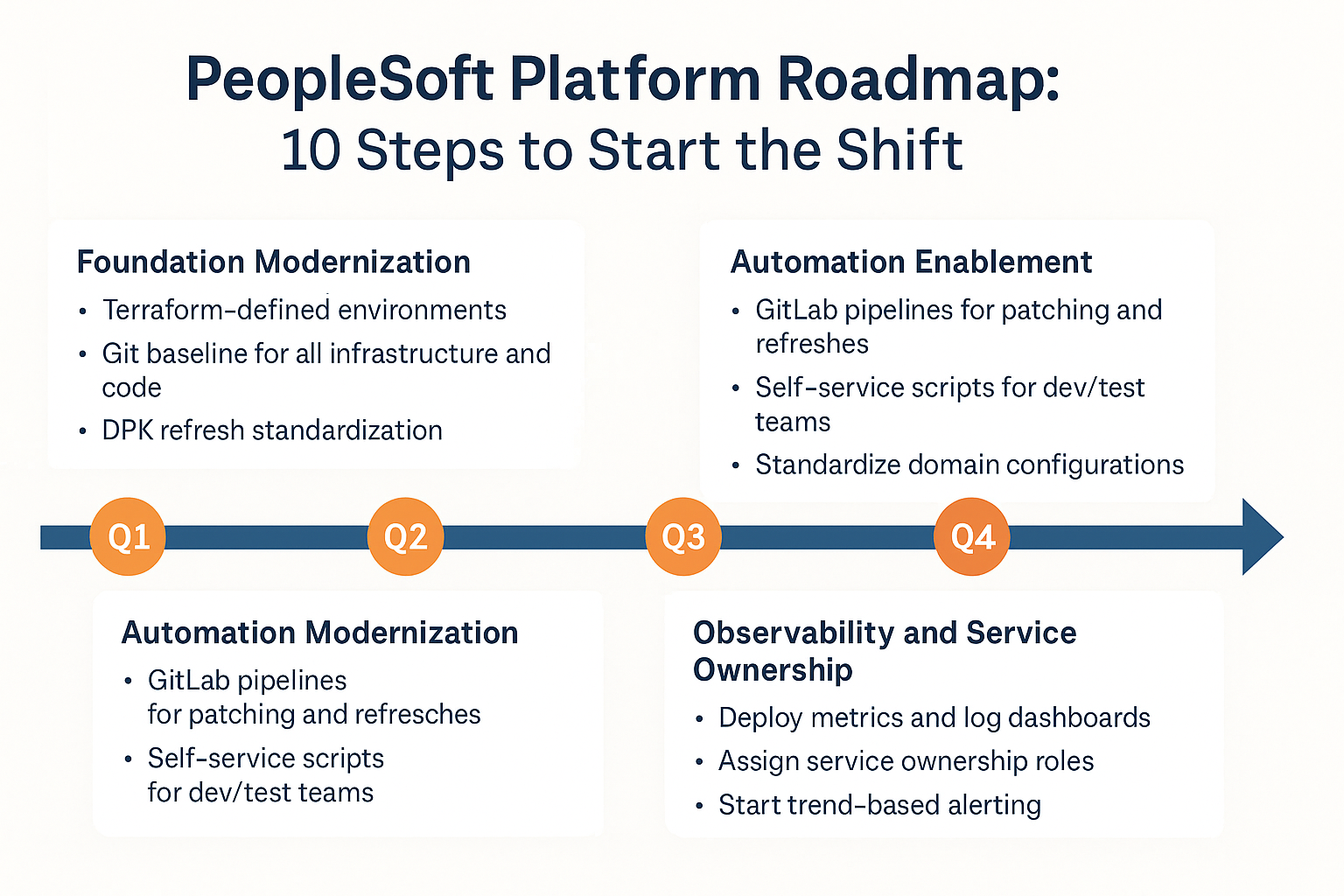Your PeopleSoft Platform Roadmap: 10 Steps to Start the Shift
Part 4 of the “Rethinking PeopleSoft” Series
Read part 1 here: Rethinking PeopleSoft: Stop Supporting. Start Enabling: Why It’s Time to Rethink PeopleSoft as a Platform
Read part 2 here: Rethinking PeopleSoft: What Actually Changes When PeopleSoft Becomes a Platform?
Read part 3 here: Customizing the Right Way: Building on the PeopleSoft Platform, Not Against It
Your PeopleSoft Platform Roadmap: 10 Steps to Start the Shift
It’s one thing to talk about platform thinking. It’s another thing to actually build it.
If you’ve been following this series, you already know why shifting from application support to platform enablement matters, and how it changes your team’s role, development practices, and customization strategy. But how do you start the transformation?
This post is your tactical guide. Whether you’re leading a PeopleSoft team or influencing platform strategy from within, here are 10 high-impact initiatives to move from “supporting” PeopleSoft to engineering it like a modern platform.
🔟 The 10-Step Platform Transition Plan
- Reframe Your Team Identity: Start by changing the narrative from “PeopleSoft sysadmins” to “PeopleSoft platform team.” This mindset shift matters. Your new mission is to enable others, deliver internal tools, and treat the system as a product.
- Adopt Infrastructure as Code (IaC): Provision environments with Terraform, manage configuration with Chef, and version everything in Git. IaC is the backbone of consistency and repeatability, serving as your gateway to automation.
- Centralize Code and Config in Git: Get all DPKs, PeopleCode, SQL scripts, and config files under version control. No more mystery SQRs on someone’s desktop. Every change should be tracked, reviewable, and portable.
- Build GitOps Pipelines: Create lightweight CI/CD pipelines for domain restarts, patches, refreshes, and deployments. Utilize GitLab or Jenkins to automate workflows that eliminate manual, one-off steps.
- Define and Assign Service Ownership: Move away from generic “environment” ownership and instead assign ownership of services, like Integration Broker, cache management, app domain tuning, or patch automation. Give your team clear domains of expertise.
- Introduce Observability: Deploy tools like OpenTelemetry, Prometheus, OpenSearch, or Splunk to track logs, metrics, and traces. Build dashboards that surface problems before users report them. Observability is a core feature of any platform.
- Standardize Customization Patterns: Define how to extend PeopleSoft safely using Drop Zones, Event Framework, and Page/Field Configurator. Create internal “design patterns” for common changes and train devs to follow them.
- Build Developer Self-Service Tools: Provide developers and testers with tools to restart domains, pull logs, refresh data, and clear caches, without needing to open a ticket. CLI tools, internal dashboards, or even scripts go a long way here.
- Automate Patching and Refreshes: Turn routine maintenance into repeatable, automated workflows. Use Git-driven patch jobs, scheduled refreshes, and consistent domain deployments that run with minimal intervention.
- Create and Share a Roadmap: Publish a living roadmap for your platform team. Break it into quarterly themes. Share progress with stakeholders. Treat PeopleSoft like a product you own and keep iterating on it.
🗓️ What a Quarterly Roadmap Might Look Like
Here’s a sample breakdown to help shape your first 12–18 months:
Q1: Foundation Modernization
- Terraform-defined environments
- Git baseline for all infrastructure and code
- DPK refresh standardization
Q2: Automation Enablement
- GitLab pipelines for patching and refreshes
- Self-service scripts for dev/test teams
- Standardize domain configurations
Q3: Observability and Service Ownership
- Deploy metrics and log dashboards
- Assign service ownership roles
- Start trend-based alerting
Q4: Developer Experience
- Launch a Dev Portal (or wiki)
- Finalize customization patterns and documentation
- Monitor developer feedback and usage
Final Thought
You don’t build a PeopleSoft platform team overnight, but you can start with the next 90 days. Focus on automation, Observability, and enabling your internal developers. Keep it iterative, visible, and tied to real business value.
In the final post of this series, we’ll discuss how to sustain this shift in the long term. How to measure success, evolve your practices, and keep PeopleSoft aligned with your broader platform strategy.
Ready to start building? You’ve got the blueprint.
